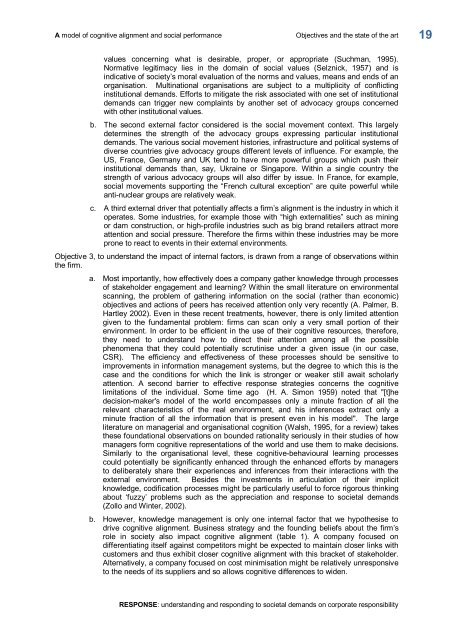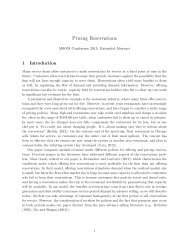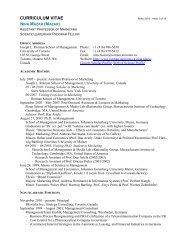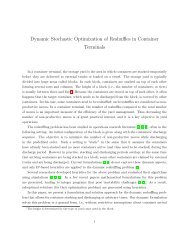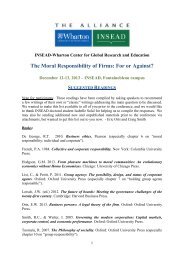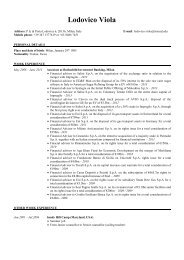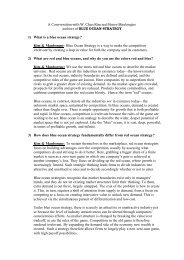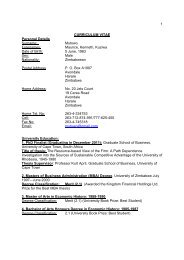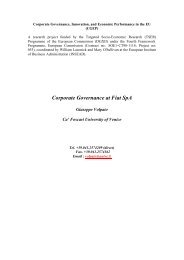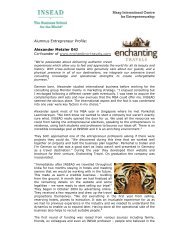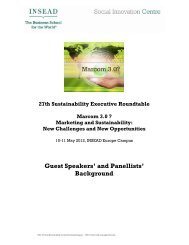RESPONSE - Insead
RESPONSE - Insead
RESPONSE - Insead
Create successful ePaper yourself
Turn your PDF publications into a flip-book with our unique Google optimized e-Paper software.
A model of cognitive alignment and social performance Objectives and the state of the art<br />
values concerning what is desirable, proper, or appropriate (Suchman, 1995).<br />
Normative legitimacy lies in the domain of social values (Selznick, 1957) and is<br />
indicative of society’s moral evaluation of the norms and values, means and ends of an<br />
organisation. Multinational organisations are subject to a multiplicity of conflicting<br />
institutional demands. Efforts to mitigate the risk associated with one set of institutional<br />
demands can trigger new complaints by another set of advocacy groups concerned<br />
with other institutional values.<br />
b. The second external factor considered is the social movement context. This largely<br />
determines the strength of the advocacy groups expressing particular institutional<br />
demands. The various social movement histories, infrastructure and political systems of<br />
diverse countries give advocacy groups different levels of influence. For example, the<br />
US, France, Germany and UK tend to have more powerful groups which push their<br />
institutional demands than, say, Ukraine or Singapore. Within a single country the<br />
strength of various advocacy groups will also differ by issue. In France, for example,<br />
social movements supporting the “French cultural exception” are quite powerful while<br />
antinuclear groups are relatively weak.<br />
c. A third external driver that potentially affects a firm’s alignment is the industry in which it<br />
operates. Some industries, for example those with “high externalities” such as mining<br />
or dam construction, or highprofile industries such as big brand retailers attract more<br />
attention and social pressure. Therefore the firms within these industries may be more<br />
prone to react to events in their external environments.<br />
Objective 3, to understand the impact of internal factors, is drawn from a range of observations within<br />
the firm.<br />
a. Most importantly, how effectively does a company gather knowledge through processes<br />
of stakeholder engagement and learning? Within the small literature on environmental<br />
scanning, the problem of gathering information on the social (rather than economic)<br />
objectives and actions of peers has received attention only very recently (A. Palmer, B.<br />
Hartley 2002). Even in these recent treatments, however, there is only limited attention<br />
given to the fundamental problem: firms can scan only a very small portion of their<br />
environment. In order to be efficient in the use of their cognitive resources, therefore,<br />
they need to understand how to direct their attention among all the possible<br />
phenomena that they could potentially scrutinise under a given issue (in our case,<br />
CSR). The efficiency and effectiveness of these processes should be sensitive to<br />
improvements in information management systems, but the degree to which this is the<br />
case and the conditions for which the link is stronger or weaker still await scholarly<br />
attention. A second barrier to effective response strategies concerns the cognitive<br />
limitations of the individual. Some time ago (H. A. Simon 1959) noted that "[t]he<br />
decisionmaker's model of the world encompasses only a minute fraction of all the<br />
relevant characteristics of the real environment, and his inferences extract only a<br />
minute fraction of all the information that is present even in his model". The large<br />
literature on managerial and organisational cognition (Walsh, 1995, for a review) takes<br />
these foundational observations on bounded rationality seriously in their studies of how<br />
managers form cognitive representations of the world and use them to make decisions.<br />
Similarly to the organisational level, these cognitivebehavioural learning processes<br />
could potentially be significantly enhanced through the enhanced efforts by managers<br />
to deliberately share their experiences and inferences from their interactions with the<br />
external environment. Besides the investments in articulation of their implicit<br />
knowledge, codification processes might be particularly useful to force rigorous thinking<br />
about ‘fuzzy’ problems such as the appreciation and response to societal demands<br />
(Zollo and Winter, 2002).<br />
b. However, knowledge management is only one internal factor that we hypothesise to<br />
drive cognitive alignment. Business strategy and the founding beliefs about the firm’s<br />
role in society also impact cognitive alignment (table 1). A company focused on<br />
differentiating itself against competitors might be expected to maintain closer links with<br />
customers and thus exhibit closer cognitive alignment with this bracket of stakeholder.<br />
Alternatively, a company focused on cost minimisation might be relatively unresponsive<br />
to the needs of its suppliers and so allows cognitive differences to widen.<br />
<strong>RESPONSE</strong>: understanding and responding to societal demands on corporate responsibility<br />
19


